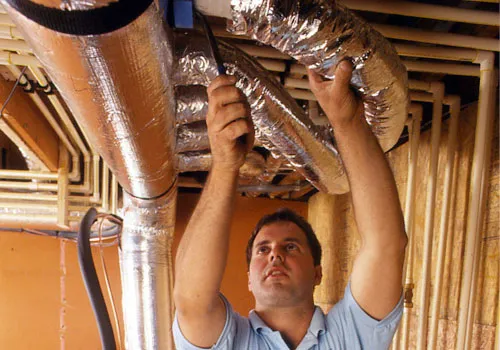Space Efficiency:
High-velocity air conditioning systems are great because they make good use of available space. Massive ductwork is often necessary for the distribution of air in older HVAC systems. However, high-velocity systems may be easily retrofitted into existing buildings or installed in locations with limited capacity for ducting because they use smaller, more flexible ducts.
Due to their small size, these systems provide additional installation possibilities, making them ideal for places like historic houses or structures where maintaining the building’s architecture is of the utmost importance. Minimizing the influence on the space’s aesthetics is possible by discretely routing the smaller ducts through walls, ceilings, or even floors.
Even Temperature Distribution:
A consistent temperature across the room is easily achieved with a high-velocity air conditioning system. Rapid and effective dispersion of conditioned air is ensured by the enhanced air velocity, reducing temperature fluctuations across various sections of a space. This function is especially helpful in open floor designs or bigger rooms where conventional heating systems would have trouble maintaining a constant temperature.
Because there are no hot or cold areas, as is sometimes the case with traditional HVAC systems, the temperature is evenly distributed, making the space more comfortable for everyone. A number of elements work together to produce this consistency, such as accurate air distribution and high-velocity systems’ capacity to get over the difficulties presented by complex or lengthy ductwork.
Adaptability to Older Structures:
When it comes to accommodating older buildings, high-velocity air conditioning systems really excel. Due to space constraints, traditional ducting may not be able to be installed in many older houses or structures. Because of their smaller and more flexible ducts, high-velocity systems are able to effortlessly integrate into existing buildings without damaging their historic appearances. Because of their adaptability, they are a great option for anyone who want to update existing structures without making major changes.
Enhanced Humidity Control:
One major advantage of high-velocity air conditioning systems is their ability to effectively regulate humidity. These devices are able to extract more moisture from the air due to the higher air velocity. Because too much moisture may cause pain and contribute to problems like mold development, this function is especially useful in areas with high humidity levels. Improved comfort and a healthier interior environment are two outcomes of high-velocity systems’ efficient management of humidity levels.
Quick Cooling and Heating Response:
High-velocity HVAC systems can quickly respond to changes in temperature settings, thanks to their design. With fewer ducts and faster airflow, conditioned air may be transferred more quickly, reducing the amount of time needed to reach the target temperature inside. This responsiveness is especially helpful when people need to quickly change the temperature, which improves comfort and saves energy.
Ductwork Aesthetics:
Apart from their practical benefits, the smaller and more flexible ducts used in high-velocity systems also help to enhance the overall look of the ducting. Conventional HVAC ducts may be large and obtrusive, requiring substantial renovations to make them work. The installation of high-velocity ducts, on the other hand, is more visually pleasant since they are simpler to hide. This characteristic greatly enhances the adaptability of high-velocity air conditioning systems, making them ideal for areas that prioritize a clean and concealed look.
Reduced Energy Losses Through Duct Leakage:
Compared to conventional HVAC systems, high-velocity air conditioning systems greatly reduce energy losses caused by duct leakage. There is less room for air leakage in high-velocity systems because the smaller ducts are sealed well. Improved energy efficiency and the efficient delivery of conditioned air to its destination are both achieved by this improved sealing. In order to reduce their impact on the environment and save money, high-velocity systems work to reduce energy loss via duct leakage.
Enhanced Air Circulation in Hard-to-Reach Areas:
High-velocity systems provide for better air circulation by increasing air velocity, which allows them to reach regions that could be difficult for conventional HVAC settings to reach. Spaces with unusual layouts or interesting architecture will benefit greatly from this. Comfort issues in difficult building layouts may be addressed by efficiently distributing conditioned air to hard-to-reach areas, creating a more uniform and thorough interior environment.
Potential for Energy Recovery Systems:
Integrating energy recovery systems with high-velocity air conditioning systems has the potential to further optimize energy efficiency. Energy recovery systems condition entering fresh air by reusing the heat energy from exhaust air. By easing the burden on the HVAC system, this technique improves overall efficiency and helps promote sustainable energy habits. Because it works with energy recovery systems, high-velocity air conditioning is a cutting-edge option for those who want to keep their homes comfortable without causing too much of an environmental problem.
Adaptive Fan Control for Varied Cooling Demands:
Adaptive fan control is a common feature in high-velocity HVAC systems, enabling operation at varied speeds according to cooling needs. With this adaptive control, the system can precisely and efficiently regulate the temperature by adjusting the fan speed in response to variations in the demand. There is a rising focus on smart and adaptable HVAC technology, and high-velocity systems are a good fit since they optimize energy use by dynamically responding to the space’s cooling demands.
Resilience Against Pressure Loss:
High-velocity AC systems are designed to withstand duct pressure losses better. Conditioned air may still reach its target, even with long or complicated duct systems, because of the greater air velocity, which helps overcome resistance. Because of their resistance to pressure loss and the constant performance they provide, high-velocity systems are a good fit for bigger houses or buildings where conventional HVAC systems have trouble keeping the temperature stab

